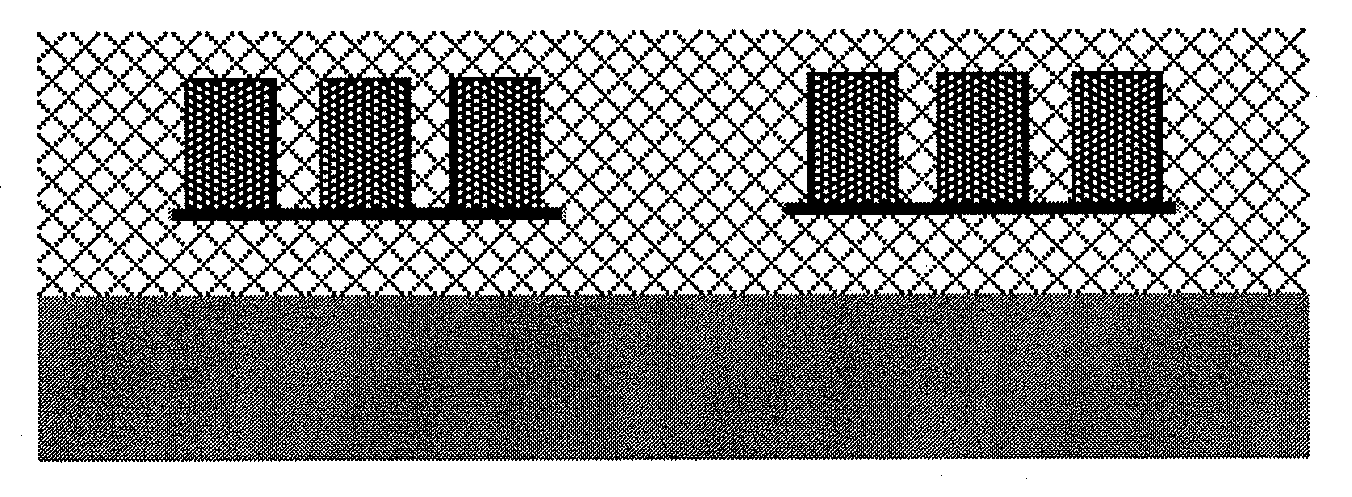Process for making customized particles by stochastic excitation
a technology of stochastic excitation and particle composition, applied in the direction of photomechanical apparatus, mechanical vibration separation, instruments, etc., can solve the problems of limiting the range of particle sizes and shapes that can be created limiting the range of particle sizes and shapes that can be produced in an efficient and cost-effective manner, and limiting the range of particle sizes and shapes that can be produced in a discrete, low-defect, high-complexity structure mass-
- Summary
- Abstract
- Description
- Claims
- Application Information
AI Technical Summary
Benefits of technology
Problems solved by technology
Method used
Image
Examples
first example embodiment
the Current Invention
[0073]A simple example embodiment of the process for creating desired complex-shaped particles using the approach of stochastic agitation of pre-configured lithographic sub-structures is as follows. This embodiment utilizes spin-coating as a deposition method, spatially patterned radiation based on a pre-designed mask as the patterning method, a radiation-sensitive material that can be made resistant to development and is rigid as a rigid sub-structure material, and stochastic thermal fluctuations (i.e. thermal energy), mediated by the fluid material, as the source of energetic excitations of the sub-structures subsequent to release from a substrate.
[0074]Step #1: Design and fabricate a mask pattern containing a plurality of sets of pre-configured sub-structures that can form a plurality of particles, wherein, for each particle, said pre-configured sub-structures are in close relative proximity and alignment, providing a close approximation of a portion of the d...
second example embodiment
the Current Invention
[0086]A lithomeric particle comprising a plurality of solid rigid sub-structures (e.g. plates or rods) that have pre-specified shapes that are interconnected to at least one other rigid sub-structure by an interconnecting sub-structure, typically made of a deformable material, and can reconfigure to cause a change in shape of the lithomeric particle (in one or more dimensions), such that each of the plurality of rigid sub-structures, once reconfigured, can be bonded together to form a desired particle shape while also inhibited from bonding to form an undesired particle shape, wherein said lithomeric particles are typically dispersed in a fluid material. Rigid sub-structures are typically mass-produced in proximity to each other using a lithographic method. Interconnecting sub-structures are typically made of a flexible non-fluid material. Interconnecting sub-structures can be manufactured lithographically or created by coating, adsorption, or other deposition p...
third example embodiment
the Current Invention
[0087]According to an embodiment of the current invention, a plurality of complex-shaped particles are fabricated using spatially patterned radiation on a flat substrate that has been coated with a layer of a release material, as shown in FIGS. 1B-1G. In this example embodiment, a thin interconnecting layer of radiation-sensitive material, which connects thicker proximate rigid sub-structures, can be flexible enough to facilitate deformation (e.g. bending) of the interconnecting material subsequent to release of the particles into a fluid material. For example, an anisotropic flow of a liquid developer in contact with an exposed radiation-sensitive material (e.g. a photoresist) creates thin interconnections between thicker, more rigid sub-structures. Due to the flexibility of the interconnecting structures, when the particle in the fluid material is excited by thermal energy and / or an externally applied energetic excitation, the interconnecting material can defo...
PUM
| Property | Measurement | Unit |
|---|---|---|
| length | aaaaa | aaaaa |
| thickness | aaaaa | aaaaa |
| edge length | aaaaa | aaaaa |
Abstract
Description
Claims
Application Information
 Login to View More
Login to View More - R&D
- Intellectual Property
- Life Sciences
- Materials
- Tech Scout
- Unparalleled Data Quality
- Higher Quality Content
- 60% Fewer Hallucinations
Browse by: Latest US Patents, China's latest patents, Technical Efficacy Thesaurus, Application Domain, Technology Topic, Popular Technical Reports.
© 2025 PatSnap. All rights reserved.Legal|Privacy policy|Modern Slavery Act Transparency Statement|Sitemap|About US| Contact US: help@patsnap.com



